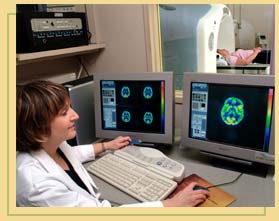












|
 |
| |
A
maternal link to prostate cancer?
Retinal chips
Addressing disparities in cardiovascular
health
Safer teens behind the wheel
In search of a better transplant drug
Aging with less grace, spatially speaking
Junk DNA and social behavior
|
Finding
missing cases of HIV
Female sex hormone reduces stress response
Treating depression, deep within the brain
Easy on the heart and wallet
Applying nanotechnology to cardiovascular
disease
Eat mor veggees |
|
|
|
|
| |
A
maternal link to prostate cancer?
More
than 20 million men in the united states
with a particular set of inherited characteristics and mutations
in mitochondrial DNA (mtDNA) are at significantly increased risk
for developing renal and prostate cancers, according to research
at Emory. Mitochondrial DNA, which contains a small number of
genes inherited mainly from the mother, is found in the hundreds
of mitochondria located in the cytoplasm outside of each cell’s
nucleus.
 Emory
urologist John Petros has found variations in
the mtDNA of men from the general population compared with men
with renal and prostate cancer. His study showed that only 9.6%
of the general population of Caucasian American participants had
mtDNA in haplogroup U. By contrast, 16.7% of prostate cancer patients
and 20.7% of renal cancer patients exhibited the haplogroup U
signature. A haplotype is a combination of variations in a gene. Emory
urologist John Petros has found variations in
the mtDNA of men from the general population compared with men
with renal and prostate cancer. His study showed that only 9.6%
of the general population of Caucasian American participants had
mtDNA in haplogroup U. By contrast, 16.7% of prostate cancer patients
and 20.7% of renal cancer patients exhibited the haplogroup U
signature. A haplotype is a combination of variations in a gene.
In addition to variations in haplogroup, Petros also found that
12% of prostate cancer patients had mutations in the COI gene,
an mtDNA cytochrome oxidase subunit, compared with less than 2%
of patients who were cancer-free.
In a second Emory study on prostate
cancer, led by Winship Cancer Institute’s Jin-Tang Dong,
researchers found that a gene named ATBF1 may contribute to the
development of prostate cancer through acquired mutations and/or
loss of expression. Although previous research has suggested that
a section of chromosome 16 harbors a tumor-suppressor gene in
several types of human cancers, the particular gene responsible
has not been identified previously.
By studying the genes within the
section of chromosome 16, the Emory team found that ATBF1 was
a strong candidate for an important tumor-suppressor gene because
its function is frequently lost in prostate cancer through gene
mutations and/or loss of expression. In addition, ATBF1 was found
to inhibit cell growth in culture dishes. A tumor-suppressor gene
is a gene whose loss of function contributes to the development
of cancer.
ATBF1 helps regulate the expression
of other genes. If its function is impaired by mutations or loss
of expression, a cell could lose the control of cancer genes.
The Myb oncogene, for example, is normally inhibited by ATBF1,
but it can be activated if ATBF1 is lost.
“Sporadic cancers often are
the result of multiple genetic alterations that accumulate over
time,” says Dong, “but only a small number of genes
have been shown to undergo these frequent mutations. Because ATBF1
inhibits cell proliferation, frequent acquired mutations that
inhibit the gene, such as the ones we found, could lead to a lack
of growth control in prostate cancer. Because gene deletion in
chromosome 16 is common in many types of cancer, including lung,
head and neck, nasopharynx, stomach, breast, and ovary, ATBF1
could be involved in the development of these cancers as well.”
|
|
|
|
|
| |
| |
|
|
| |
Retinal
chips
|
|
| |
In
an expanded clinical trial, Emory surgeons have implanted a tiny retina microchip, much
smaller than a penny, in several patients with retinitis
pigmentosa to determine if it will improve functional or
slow progression of vision loss. Five patients with moderate-to-severe
vision loss participated in the experimental treatment,
developed by Optobionics Corp. Researchers hope the retinal
chips will improve the quality of life for patients with
this debilitating disease.
Emory surgeons have implanted a tiny retina microchip, much
smaller than a penny, in several patients with retinitis
pigmentosa to determine if it will improve functional or
slow progression of vision loss. Five patients with moderate-to-severe
vision loss participated in the experimental treatment,
developed by Optobionics Corp. Researchers hope the retinal
chips will improve the quality of life for patients with
this debilitating disease. |
|
| |
|
|
|
|
|
|
|
| |
| |
|
|
| |
Addressing
disparities in cardiovascular health
|
|
| |
 The
NIH has awarded Emory and Morehouse School of Medicine $6
million for a five-year partnership to address health disparities
between African Americans and Caucasians at high risk for
cardiovascular disease. The program is one of six nationwide
funded by the National Heart, Lung and Blood Institute. The
NIH has awarded Emory and Morehouse School of Medicine $6
million for a five-year partnership to address health disparities
between African Americans and Caucasians at high risk for
cardiovascular disease. The program is one of six nationwide
funded by the National Heart, Lung and Blood Institute.
Known as META-Health (Morehouse
and Emory are Teaming up to eliminAte Health Disparities),
the Atlanta program will focus on metabolic syndrome, a
cluster of health risk factors that includes hypertension,
abnormal cholesterol, high triglycerides, abdominal obesity,
and elevated blood glucose. People with three of these factors
are identified as having metabolic syndrome, indicating
a high risk for diabetes and cardiovascular disease.
The first goal of the study
is to identify differences in risk factors in African Americans
and Caucasians. The research team then will develop and
test targeted interventions aimed at improving overall cardiovascular
health.
Earlier studies indicate that
African Americans and Caucasians experience metabolic syndrome
differently, according to cardiologist Arshed Quyyumi, who
is leading Emory’s team. African Americans appear
to have lower incidence of cholesterol and triglyceride
abnormalities with a similar frequency of insulin resistance,
factors that contribute to underdiagnosis of the condition.
In addition, evidence suggests
that children of patients with the syndrome are at increased
risk of developing obesity and insulin resistance. META-Health
researchers hope to establish a genomic database to identify
genetic differences that would account for some of these
complications and disparities. |
|
| |
|
|
|
|
|
|
|
| |
Safer
teens behind the wheel
Georgia’s
strong teen driving laws are working. In 1997, the Teenage and
Adult Driver Responsibility Act went into effect, ushering in
incentives to deter excessive speeding, consumption of alcohol
while driving, and other dangerous driving behaviors. It also
introduced graduated licensing, with provisions to restrict late- night
driving and the number of passengers in a teen’s vehicle.
Emory researchers—led by Emergency Medicine Chair Arthur
Kellermann—recently completed a study to evaluate the law’s
long-term impact. They found that the rate of fatal crashes among
16-year-olds was 36.8% less than in the previous 5-1/2 years for
the same age group. Fatal crashes involving 17-year-olds also
were reduced. In comparing the driving results of 21-year-olds
in 1997 with those who turned 21 after the law’s enactment,
researchers found a 38% lower fatal crash rate for the group who
learned to drive under the new rules. night
driving and the number of passengers in a teen’s vehicle.
Emory researchers—led by Emergency Medicine Chair Arthur
Kellermann—recently completed a study to evaluate the law’s
long-term impact. They found that the rate of fatal crashes among
16-year-olds was 36.8% less than in the previous 5-1/2 years for
the same age group. Fatal crashes involving 17-year-olds also
were reduced. In comparing the driving results of 21-year-olds
in 1997 with those who turned 21 after the law’s enactment,
researchers found a 38% lower fatal crash rate for the group who
learned to drive under the new rules. |
|
|
|
|
| |
| |
|
|
| |
In
search of a better transplant drug
|
|
| |
|
|
| |
For
the past 20 years, doctors have treated transplant patients
with cyclosporine to suppress the immune system and prevent
organ rejection. However, the medication shuts down the
immune system, increases the risk of heart attacks, and
can damage the kidneys.
An investigational medication,
known as LEA29Y (belatacept), is proving effective in preserving
transplanted kidney function while avoiding those toxic
side effects. The preclinical research conducted with nonhuman
primates at the Yerkes National Primate Research Center
has led to human clinical trials to develop an effective
alternative to current therapies.
Chris Larsen (above) and Thomas
Pearson of the Emory Transplant Center with colleagues at
Bristol-Myers Squibb developed LEA29Y to selectively block
the second of two cellular signals—the co-stimulatory
signal—that the body needs to trigger an immune response.
Blocking this signal prevents organ rejection while allowing
the body to continue fighting other infections. Cyclosporine,
by contrast, indiscriminately targets and blocks other cellular
signal pathways.
Following in vitro studies,
during which the researchers observed LEA29Y was 10 times
more effective than cyclosporine in blocking the co-stimulatory
immune signal, Larsen and Pearson tested the drug in nonhuman
primates and found it significantly prolonged survival of
transplanted kidneys.
The research team recently
completed a phase 2 clinical study comparing LEA29Y with
cyclosporine in human kidney transplant patients. |
|
| |
|
|
|
|
|
|
|
|
| |
Aging
with less grace, spatially speaking
When
it comes to aging, women may have another advantage over men.
Research conducted at Yerkes National Primate Research Center
shows that male nonhuman primates are more susceptible to age-related
cognitive decline than females.
In the study, neuroscientists Agnes
Lacreuse and James Herndon observed young and elderly nonhuman
primates performing tasks that measured spatial memory, which
records environmental and spatial-orientation information. The
researchers presented  each
animal with an increasing number of identical disks, and the animals
had to identify each disk as it appeared in a new location. each
animal with an increasing number of identical disks, and the animals
had to identify each disk as it appeared in a new location.
The young adult males outperformed
the females, a finding consistent with human data that shows men
have a higher capacity than women for maintaining or updating
spatial information. Among older nonhuman primates, the researchers
found cognitive decline in both sexes. However, sex differences
in the spatial memory performance tasks had disappeared. The finding
suggests that spatial abilities declined at a greater rate in
males than in females as they got older.
On the human front, an NIH clinical
trial that included Emory researchers examined the ability of
drugs to prevent or delay the onset of Alzheimer’s disease.
Patients with mild cognitive impairment who were treated with
Aricept had a lower rate of progression to symptoms of Alzheimer’s
during the early part of treatment. Vitamin E, however, was found
to have no benefit in delaying the disease. |
|
|
|
|
| |
| |
|
|
| |
Junk
DNA and social behavior
|
|
| |
Why
are some people shy while others are outgoing?
A recent study in Science demonstrates for the first time
that social behavior may be shaped by differences in the
length of seemingly nonfunctional DNA, sometimes referred
to as junk DNA. The finding by researchers at Yerkes National
Primate Research Center and the Center for Behavioral Neuroscience
has implications for understanding human social behavior
and disorders, such as autism.
The study examined whether
the junk DNA, formally known as microsatellite DNA, associated
with the vasopressin receptor gene affects social behavior
in male prairie voles, a rodent species. Researchers bred
two groups of prairie voles with short and long versions
of the junk DNA. By comparing the behavior of male offspring
after they matured, they discovered microsatellite length
affects gene expression patterns in the brain.
In the prairie voles, males
with long microsatellites had higher levels of vasopressin
receptors in brain areas involved in social behavior and
parental care, particularly the olfactory bulb and lateral
septum. These males spent more time investigating social
odors and approached strangers more quickly. They also were
more likely to form bonds with mates, and they spent more
time nurturing their offspring. |
|
| |
|
|
|
|
|
|
|
| |
Finding
missed cases of HIV
 Although
standard tests that measure antibody response to HIV have become
increasingly sensitive, cases are still missed. In a recent study,
researchers at Emory, the University of North Carolina at Chapel
Hill, and the Georgia Department of Human Resources used nucleic
acid amplification testing (NAAT) in addition to standard tests
to screen clients at urban clinics and HIV testing sites in Atlanta.
The combined approach, they found, uncovered 6% more cases of
HIV infection than current standard practice. Although
standard tests that measure antibody response to HIV have become
increasingly sensitive, cases are still missed. In a recent study,
researchers at Emory, the University of North Carolina at Chapel
Hill, and the Georgia Department of Human Resources used nucleic
acid amplification testing (NAAT) in addition to standard tests
to screen clients at urban clinics and HIV testing sites in Atlanta.
The combined approach, they found, uncovered 6% more cases of
HIV infection than current standard practice.
NAAT-based screening can identify
people with acute HIV infection earlier when they may be most
infectious and at risk for spreading the virus, according to Emory
infectious disease specialist Frances Priddy (above), who recently
presented the findings at the 12th Conference on Retroviruses
and Opportunistic Infections. |
|
|
|
|
| |
| |
|
|
| |
Female
sex hormone reduces stress response
|
|
| |
A
steroid hormone released during the metabolism of progesterone
reduces the brain’s response to stress in rats, according
to research by scientists at Emory School of Medicine, Yerkes
National Primate Research Center, and the Center for Behavioral
Neuroscience. The researchers found that allopregnanolone,
a progesterone metabolite, reduces the brain’s response to corticotropin-releasing factor
(CRF), a hormone that plays an important role in the stress
response.
the brain’s response to corticotropin-releasing factor
(CRF), a hormone that plays an important role in the stress
response.
In a test to gauge stress
and anxiety, the researchers compared how female rats with
different levels of estrogen and progesterone reacted to
loud noises after injections of CRF. These injections usually
increase the acoustic startle response. In comparing the
acoustic startle responses after CRF injection in three
groups—estrogen-only, estrogen-plus-progesterone,
and a control group—the researchers found that the
startle response was unaffected in both the estrogen-only
and control groups. However, in the estrogen-plus-progesterone
group, CRF-enhanced startle was significantly lower.
The experiment and others
led the scientists to conclude that progesterone inhibits
the effect of CRF on the acoustic startle response. This
finding correlates with clinical evidence that some people
suffering from depression and anxiety have low allopregnanolone
levels that normalize after treatment with anti-depressant
medications. The research, published in the Journal of Neuroscience,
could lead to drug development and new approaches for controlling
mood disorders in women. |
|
| |
|
|
|
|
|
|
|
| |
Treating
depression, deep within the brain
 Deep
brain stimulation may have clinical benefits for people
with severe depression who have failed other treatments, according
to a study published in the March issue of Neuron. In
previous studies at the University of Toronto, where she began
the research, Helen Mayberg, now a professor in the Departments
of Psychiatry and Behavioral Sciences and Neurology at Emory,
found that the subgenual cingulate region of the brain (Cg25)
plays a critical role in modulating sadness and negative mood
states in both healthy and depressed people. She wondered if stimulation
of this region could improve the treatment of depression, as with
other neurologic disorders such as Parkinson’s disease,
epilepsy, and dystonia. Deep
brain stimulation may have clinical benefits for people
with severe depression who have failed other treatments, according
to a study published in the March issue of Neuron. In
previous studies at the University of Toronto, where she began
the research, Helen Mayberg, now a professor in the Departments
of Psychiatry and Behavioral Sciences and Neurology at Emory,
found that the subgenual cingulate region of the brain (Cg25)
plays a critical role in modulating sadness and negative mood
states in both healthy and depressed people. She wondered if stimulation
of this region could improve the treatment of depression, as with
other neurologic disorders such as Parkinson’s disease,
epilepsy, and dystonia.
Guided by MRI, Mayberg’s team
implanted thin wire electrodes in the brain region of Cg25 in
six patients. The wires were connected under the skin of the neck
to a pacemaker-like device that directed the electric current.
During the six-month study, four
of the six patients showed a significant response with sustained
improvement. PET scans also showed a significant response in the
frontal cortex, hypothalamus, and brainstem, consistent with findings
seen with successful response to medication or psychotherapy in
less severely ill patients.
This
study was the culmination of 15 years of research using brain
imaging technology, says Helen Mayberg (shown above). |
|
|
|
|
| |
| |
|
|
| |
Easy
on the heart and the wallet
|
|
| |
The
drug eplerenone, which blocks aldosterone—a hormone involved in regulating
blood levels of sodium and potassium as well as the constriction
of blood vessels—not only helps people with heart
disease live longer, it also is cost-effective, according
to an international study, led by the Emory Heart Center’s
William Weintraub. Researchers found a significant decrease
in mortality in patients with left ventricular systolic
dysfunction and congestive heart failure following heart
attack. Also, the drug added only about $3.60 (wholesale),
on average, to treatment costs. In further analysis, researchers
calculated the cost for each quality-life-year gained by
patients treated with eplerenone at $13,178. “Health
economists generally regard any price below $50,000 a year
as cost-effective,” Weintraub says.
blocks aldosterone—a hormone involved in regulating
blood levels of sodium and potassium as well as the constriction
of blood vessels—not only helps people with heart
disease live longer, it also is cost-effective, according
to an international study, led by the Emory Heart Center’s
William Weintraub. Researchers found a significant decrease
in mortality in patients with left ventricular systolic
dysfunction and congestive heart failure following heart
attack. Also, the drug added only about $3.60 (wholesale),
on average, to treatment costs. In further analysis, researchers
calculated the cost for each quality-life-year gained by
patients treated with eplerenone at $13,178. “Health
economists generally regard any price below $50,000 a year
as cost-effective,” Weintraub says. |
|
| |
|
|
|
|
|
|
|
| |
Applying
nanotechnology to cardiovascular disease
The
National Heart, Lung and Blood Institute (NHLBI) of the NIH has
awarded researchers from Georgia Institute of Technology and Emory
$11.5 million to establish a new research program focused on creating
advanced nanotechnologies to analyze plaque formation on the molecular
level and detect plaque at its early stages.
The multidisciplinary program, part
of NHLBI’s Program of Excellence in Nanotechnology (PEN),
is headed by Gang Bao, a professor in the Wallace H. Coulter Department
of Biomedical Engineering at Georgia Tech and Emory. The program,
one of four  national
PEN awards, includes 12 faculty from both institutions and is
based at Emory. It will focus primarily on detecting plaque and
pinpointing its genetic causes with three types of nanostructured
probes—molecular beacons, semiconductor quantum dots, and
magnetic nanoparticles. national
PEN awards, includes 12 faculty from both institutions and is
based at Emory. It will focus primarily on detecting plaque and
pinpointing its genetic causes with three types of nanostructured
probes—molecular beacons, semiconductor quantum dots, and
magnetic nanoparticles.
A molecular beacon is a biosensor
about 4 to 5 nanometers in size that can seek out and detect specific
target genes. It is a short piece of single-stranded DNA (ssDNA)
in the shape of a hairpin loop with a fluorescent dye molecule
at one end and a “quencher” molecule at the other
end. The ssDNA is synthesized to match a region on a specific
messenger RNA (mRNA) that is unique to the gene. The fluorescence
of the beacon is quenched, or suppressed, until it seeks out and
binds to a complementary target mRNA, which causes the hairpin
to open up and the beacon to emit light.
The level of gene expression within
a cell can reflect susceptibility to disease. The fluorescence
from the beacons will vary with the level of the target genes’
expression in each cell, creating a glowing marker if the cell
has a detectable level of gene expression that is known to contribute
to cardiovascular disease.
To complement these studies, the
team will develop quantum dot nanocrystal probes and use them
to study protein molecular signatures of cardiovascular disease.
Quantum dots are nanometer-sized semiconductor particles that
have unique electronic and optical properties due to their size
and highly compact structure. Quantum dot-based probes can act
as markers for specific proteins and cells and can be used to
study protein-protein interactions in live cells or to detect
diseased cells.
Other research will use magnetic
nanoparticles to detect early-stage plaques. These particles will
target specific proteins on the surface of cells in a plaque and
serve as a contrast agent in MRI, providing an image of plaque
formation. |
|
|
|
|
| |
| |
|
|
| |
Eat
mor veggees
|
|
| |
 If
the next 100 billion burgers sold under the Golden Arches
were veggie-based rather than beef, Americans’ cholesterol
levels, fiber intake, and overall health would improve,
according to an article in the May issue of the American
Journal of Preventive Medicine. Lead author Erica Frank
of Emory’s Department of Family and Preventive Medicine
compared the McVeggie burger (sold in Canada and some major
cities across the United States) to the beef burger, finding
that the switch to the plant-based choice would result in
1 billion more pounds of fiber, 550 million fewer pounds
of saturated fat, 1.2 billion fewer total pounds of fat,
and 660 million more pounds of protein. Supersize that,
and you’ve got a healthier country. If
the next 100 billion burgers sold under the Golden Arches
were veggie-based rather than beef, Americans’ cholesterol
levels, fiber intake, and overall health would improve,
according to an article in the May issue of the American
Journal of Preventive Medicine. Lead author Erica Frank
of Emory’s Department of Family and Preventive Medicine
compared the McVeggie burger (sold in Canada and some major
cities across the United States) to the beef burger, finding
that the switch to the plant-based choice would result in
1 billion more pounds of fiber, 550 million fewer pounds
of saturated fat, 1.2 billion fewer total pounds of fat,
and 660 million more pounds of protein. Supersize that,
and you’ve got a healthier country. |
|
| |
|
|
|
|
| |
|
|
| |
|
|
|
|
|





